Description and Requirements
The Book
Bibliography
Syllabus
 Introduction
Introduction The Great Pyramid
The Great Pyramid Music of the Spheres
Music of the Spheres Number Symbolism
Number Symbolism  Polygons and Tilings
Polygons and Tilings  The Platonic Solids
The Platonic Solids  Roman Architecture
Roman Architecture  Number Symbolism
in the Middle Ages
Number Symbolism
in the Middle Ages  The Wheel of Fortune
The Wheel of Fortune Celestial Themes in Art
Celestial Themes in Art  Origins of Perspective
Origins of Perspective  What Shape Frame?
What Shape Frame?  Piero della Francesca
Piero della Francesca  Leonardo
Leonardo  Façade measurement
Façade measurement Early Twentieth Century Art
Early Twentieth Century Art  Dynamic symmetry & The Spiral
Dynamic symmetry & The Spiral  The Geometric Art of M.C. Escher
The Geometric Art of M.C. Escher  Later Twentieth Century Geometry Art
Later Twentieth Century Geometry Art  Art and the Computer
Art and the Computer  Chaos & Fractals
Chaos & Fractals
The Circle,
The Wheel of Fortune
& The Rose Window
My heart leaps up when I behold ... A rainbow in the sky:
William Wordsworth (1770-1850)
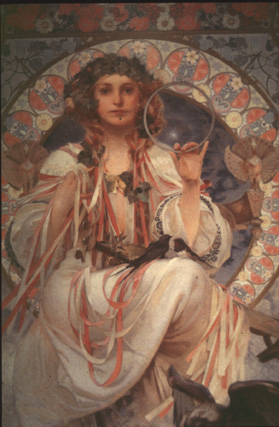
Slide 9-1: Alfons Mucha (1860-1939). Slavia, (1908) National Gallery,
Prague
VG Bild-Kunst, Bonn
| Outline: | Introduction |
| Symbolism of the circle | |
| Rose window | |
| Mandorla or Vesica | |
| Squaring the Circle | |
| Summary | |
| Reading |
Introduction
In an earlier unit we looked at the polygons, starting with the three-sided triangle and continuing to the eight-sided octagon. Now in our minds lets increase the number of sides to 9, 10, 20, 100, 1000, 1,000,000. Our polygon gets to look more and more like a circle. The circle is considered a symbol of unity, because all the regular polygons are embraced by the circle.
It is also the symbol of infinity, without beginning or end, perfect, the ultimate geometric symbol. Its a symbol of democracy and the preferred shape for an assembly of equals; the council circle, the campfire circle, and King Arthur's round table. The circle is also the easiest geometric figure to draw accurately, with stick and string or forked stick.
In this unit we'll examine the mathematics and the symbolism of the circle, and show how it was prominent in Gothic architecture, especially in the Rose window. We'll examine figures with circular boundaries like the vesica, and its use as art motifs. Finally, we'll combine circle with square for the highly symbolic squaring of the circle.
Symbolism of the Circle
The circle has many interesting associations and appears in art in a number of forms. Here, we'll look at the circle in the form of the halo, the rainbow, the ring, the wheel, and the circle dance.
The Circular Halo
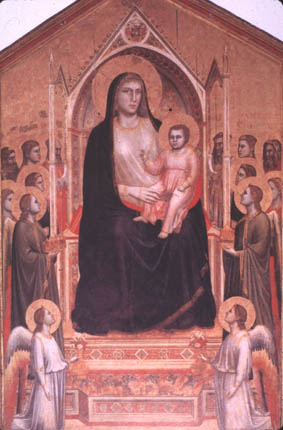
Slide 9-2: Madonna Enthroned. Giotto c. 1310.
Janson, H.W. History of Art. Fifth Edition. NY: Abrams, 1995.
Recall that a halo is a zone of light behind the head of a holy figure, like the halos we sometimes see around the sun or moon. It may have the shape of a circle or triangle. Also recall that a triangular halo is used only for God the Father.
A circular halo is used for Christ, Mary, and saints. Mary's circular halo is usually elaborately decorated. The circular halo of a saint is usually plain.
Cruciform Halo
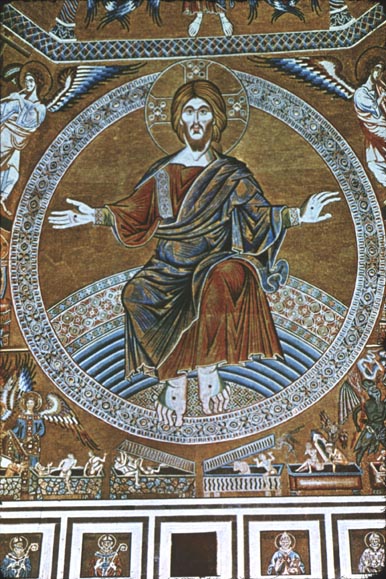
Slide 9-4: Florence Baptistry Ceiling
Nova Lux Slide Set, Firenze
The Greek cross within a circle (cruciform nimbus) is used only when portraying Christ. In the San Giovanni ceiling, notice that the figure of God is also in the shape of a Greek cross, within a circle. Both can be taken as an examples of squaring the circle.
The Rainbow
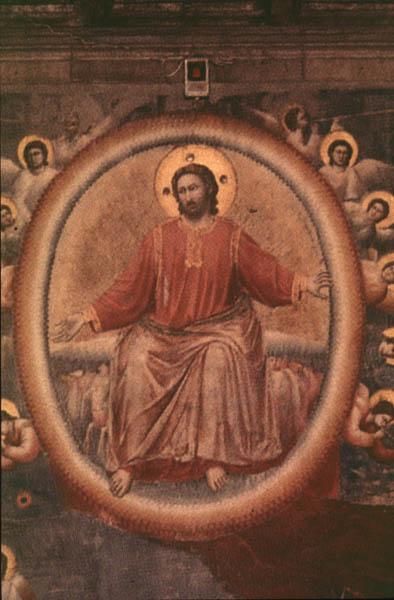
Slide 9-6: Last Judgement, closeup.Giotto, 1305. In Scrovegni chapel.
My heart leaps up when I behold, A rainbow in the sky:
William Wordsworth (1770-1850)
The circle has heavenly associations in the rainbow, which appears to touch both heaven and earth at the same time. The rainbow was often used as the Lord's throne and in scenes of the Last Judgement. When tri-colored, is associated with the Trinity.
This connection to the rainbow probably came straight from both Old and New Testaments:
Genesis Chap. 9, 13"I set my bow in the cloud, and it shall be a sign of the covenant between me and the earth."
Ezekiel 1, 26. "Like the appearance of the bow that is in the cloud on the day of rain, so was the appearance of the brightness round him."
Revelation 4, 3. From the vision of God on his throne, ". . .and round the throne was a rainbow"
Revelation 10, 1. "Then I saw another mighty angel coming down from heaven, wrapped in a cloud, with a rainbow over his head, . . ."
Iris, Goddess of The Rainbow
Iris was the Greek goddess of the rainbow, a messenger of the gods, like Hermes. She descended to earth on a rainbow, which touched both realms, representing a communication between the heavenly and the earthly.
Iris appears often in Virgil's Aeneid, as in, "The maiden Iris hurried on her way, along her rainbow with a thousand colors . . ."
The Rainbow in Painting
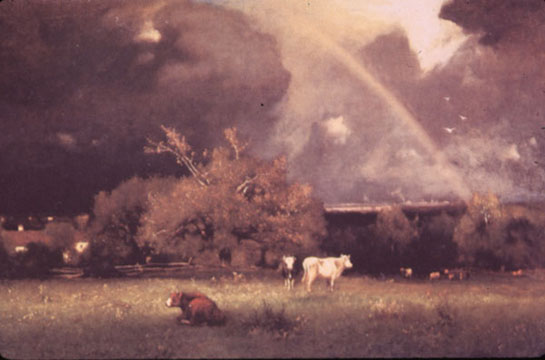
Slide 9-8: The Rainbow. c. 1878.
George Innes (1825-1894) (New Janson p. 715)
Janson, H.W. History of Art. Fifth Edition. NY: Abrams, 1995.
Innes is considered the leader of the American Barbizon School. He imbued his landscapes with a sense of divine presence and rainbows had a spiritual significance for him.
Other landscapes with rainbows include Millet's Spring, Constable's Salisbury Cathedral, and Turner's Buttermere Lake. Note how they give a spiritual feeling to the scene by connecting the earth with the heavens. This illustrates a recurring theme: The union of earthly and divine.
The Ring as a Symbol of Union
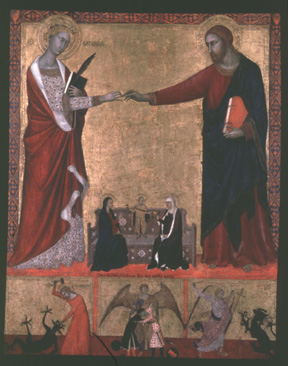
Slide 9-13: The Marriage of St. Catherine,
Barna di Siena, c. 1360
Museum of Fine Arts, Boston, Slide Collection
As a symbol for eternity, the ring is used for betrothal and marriage. Betrothal rings were an old Roman custom. Wedding rings came into use later.
A bishop's ring signifies his union with Church. A Nun's ring signifies her marriage with Christ. This slide shows Catherine of Alexandria receiving a with a ring, symbolizing her marriage to God,
The Ring as a Symbol of Authority or Status
This comes from the use of the signet ring, one used to make an impression indicating authenticity, which goes back to ancient Greece. Moreover, it is a symbol of designated authority, since a ring is easily passed to another.
In Rome, wearing of rings of various metals was strictly regulated. Citizen's rings were iron, and were forbidden to slaves.
Church rings show the ecclesiastical office of the wearer. Papal ring or Fisherman's Ring, bears image of St. Peter fishing. It is broken at Pope's death.
Magic Rings
Rings of Jasper or Bloodstone were worn by Egyptians for success in battle or other struggle.
The Koran says Solomon had a magic ring which could give him power over enemies, and transport him to a celestial sphere where he could rest from the cares of state.
Romans wore rings dedicated to the goddess Salus (Hygeia) engraved with a pentagram and a coiled snake, to ensure good fortune.
Rings made of nails from coffins or church doors were popular talismans in the Middle Ages for curing cramp and other disorders.
Other examples include Reynard the Fox, the wily hero of the medieval verse cycles known as the Beast Epics, claimed to have a magic ring bearing three mysterious Hebrew words, that would make him invisible and shield him from witchcraft. In Orlando Furioso by Ariosto, Ruggiero arrives on a Hippoghriff and places a magic ring on Angelica's finger to protect her. And of course, we have Tolkiens's Lord of the Ring:
Three rings for the Elven-kings under the sky,
Seven for the Dwarf-lords in their halls of stone,Nine for Mortal Men doomed to die,
One for the Dark Lord on his dark throneIn the Land of Mordor where the Shadows lie.
One Ring to rule them all, One Ring to find them, One Ring to bring them all, and in the darkness bind themIn the Land of Mordor where the Shadows lie.
Ouroboros
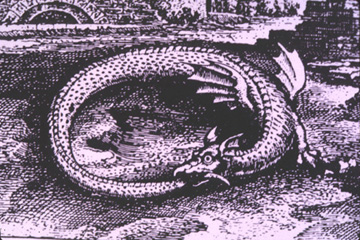
Slide 9-12: Serpent feeding on its own tail. Michael Maier, 1618. p. 101
Wasserman, James. Art and Symbols of the Occult. Vermont: Destiny, 1993.
The circle is the symbol for infinity, because the circle is endless, and may be considered a polygon with an infinite number of sides.
The snake or dragon with its tail in its mouth continually devouring itself and being reborn from itself is a symbol of eternity and of the cyclic nature of the universe. It expresses the unity of all things, which never disappear but change form in a cycle of destruction and re-creation.
It is also the alchemical symbol for chemical change. A dream about this serpent gave the chemist von Stradonitz the notion of the benzene ring, in the 19th century.
Catherine Wheel
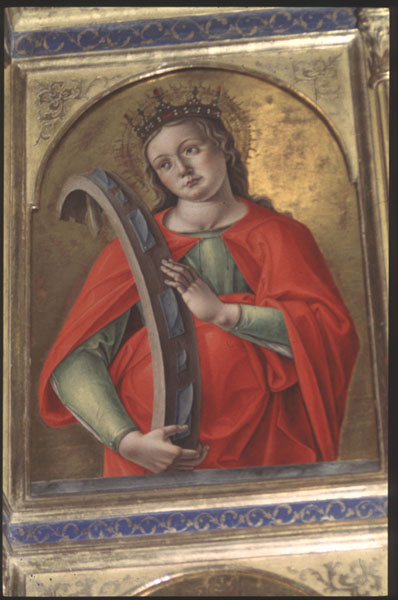
Slide 9-17: Bartolomeo Barini (1450-91), Polyptych with St. James, Virgin, Child, & Saints, detail.
The circle is the symbol of mobility, in the form of a wheel. It also appears as an instrument of torment.
Catherine of Alexandria (d. 310 AD) refused to marry the emperor, and was imprisoned. Christ appeared and she wed him, a scene depicted in art as The Mystic Marriage of St. Catherine. Enraged, the emperor had a special spiked wheel designed for her torture, but the wheel broke and she was unharmed.
Ixion
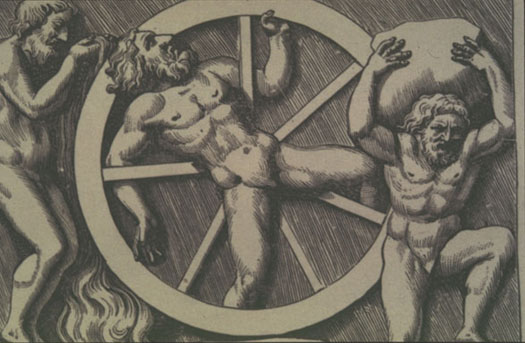
Slide 9-18: Cayley. Classical Myths in English Literature. Boston: Ginn 1893, p. 186
Ixion, in Greek mythology, was the first man to murder one of his kinspeople by killing his father-in-law to avoid giving him promised bridal gifts. He later tried to seduce Hera, the wife of Zeus.
As punishment, Ixion was bound to a wheel that revolved eternally in the underworld.
Ezekiel saw the Wheel
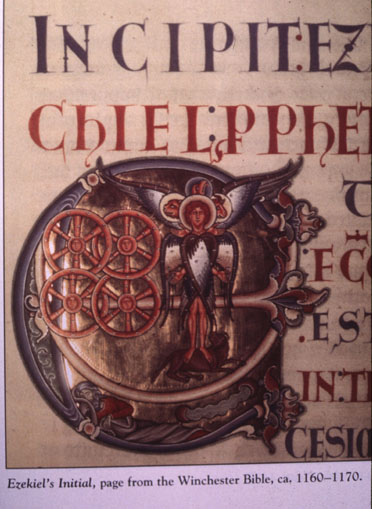
Slide 9-19: Ezekiel's Initial. Page from the Winchester Bible, c. 1165. Campbell, Joseph, with Bill Moyers. The Power of Myth. NY: Doubleday 1988. p. 109.
There is a strange passage from The Book of Ezekiel that really excites all the flying-saucer enthusiasts.
"Now as I looked . . . I saw a wheel upon the earth beside
the living creatures . . .
their construction being as it were a wheel within a wheel . . .
The four wheels had rims and they had spokes,
and their rims were full of eyes round about.
And when the living creatures went, the wheels went beside them,
and when the living creatures rose from the earth, the wheels rose.
Wherever the spirit would go, they went, and the wheels rose along with them;
for the spirit of the living creatures was in the wheels."
The Wheel of Dharma
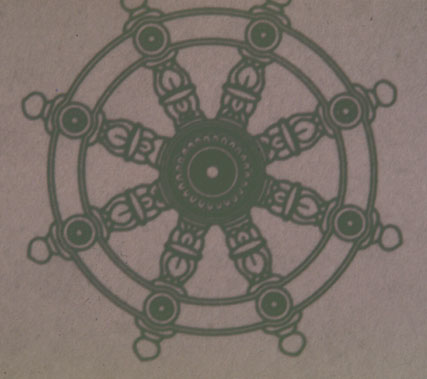
Slide 9-20: Wheel of Dharma
The Wheel of Dharma is a common symbol of Buddhism. Like the wheel of a cart that keeps turning, it symbolizes Buddha's teaching as it continues to spread endlessly. The eight spokes represent the eightfold Path of Buddha.
Prayer Wheel
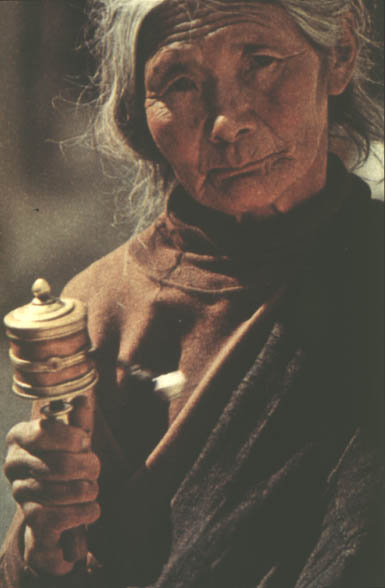
Slide 9-21: Prayer Wheel. NG Feb. '80, p. 248
National Geographic Society
Here, a Tibetan woman spins an endless prayer written on a strip of paper coiled inside the cylinder.
Rota Fortuna, The Wheel of Fortune
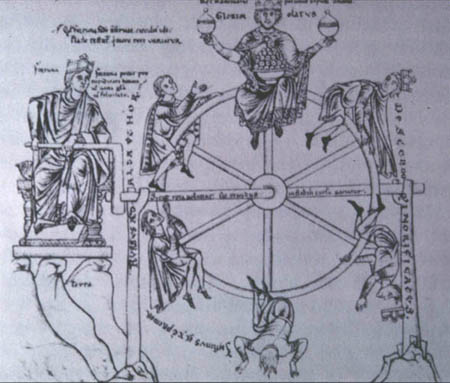
Slide 9-23: Wheel of Fortuna in Hortus Deliciarum,
Kitzinger, Ernst. The Art of Byzantium and the Medieval West. Bloomington:
Indiana, 1976. p. 351
The wheel, because it can turn, has often been associated with chance and fortune. In this picture, Fortuna is shown turning the crank on the wheel of fortune. Such depictions sometimes contained the legend.
Regnabo Regno Regnavi Sum sine regno
I shall reign I reign I reigned I don't reign
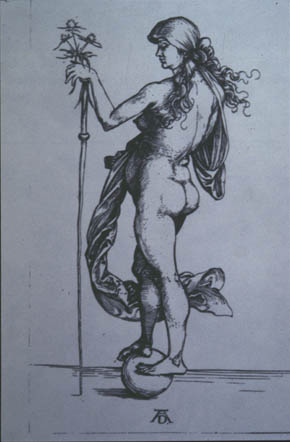
Slide 9-31: Dürer, Fortune, 1495, (Das Kleine Glück), Dürer, Albrecht. The Complete Engravings, Etchings and Drypoints. Ed. By Walter Strauss. NY: Dover, 1972. p. 14
The sphere, with its inherent instability, is also used to illustrate chance or fortune, as in this etching by Dürer.
Circle Dance
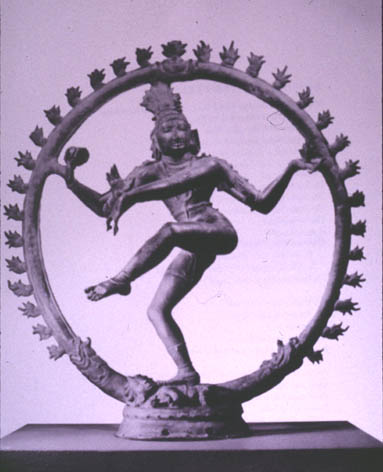
Slide 9-33: Shiva Nataraja, Lord of the Dance, South India, 11th Century
Campbell, Joseph, with Bill Moyers. The Power of Myth. NY: Doubleday 1988. p. 226
The circle dance, like the round table or council circle is democratic, where no one has a more prominent position than anyone else.
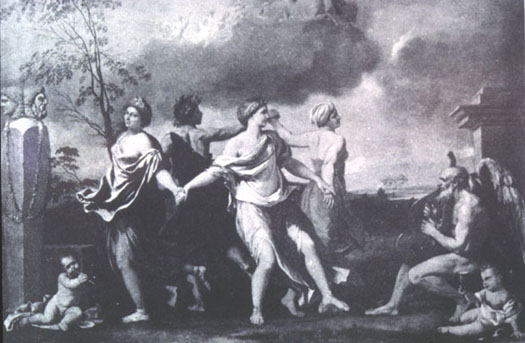
Slide 9-34: Poussin, Ballo Della Vita Humana Plate XL
Panofsky, Erwin. Studies in Iconology. NY: Harper, 1939.
Panofsky describes Poussin's, Ballo della Vita Humana as "a kind of humanized Wheel of Fortune . . . where Poverty joins hands with Labour . . . Wealth . . . Luxury and dance to the lyre of Time . . .an infant plays with Time's hourglass and another blows soap-bubbles connoting transience and futility, while Sun drives his chariot through the zodiac."
The Rose Window
Numbers and the Medieval Cathedral
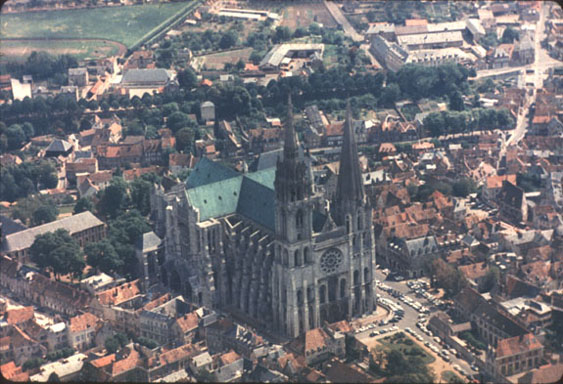
Slide 9-35: Milan Duomo Chartres Cathedral, slide # 511-A
Editions E. Houvret Slide Set
Medieval thinkers understood the mathematical aspects of number to be of divine origin. As part of the reason for this, Umberto Eco points to the triad of terms in the Book of Wisdom of Solomon, from the OT Apocrypha:
"But thou hast arranged all things by measure and number and weight."
or
Numerus, pondus, mensura.
God The Geometer
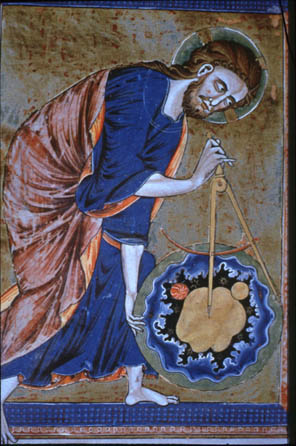
Slide 9-37: God the Geometer, Manuscript illustration.
Clark, Kenneth. Civilization. NY: Harper, 1969. p. 52
The importance of number symbolism was matched by a dedication to geometry. Kenneth Clark points out that ". . . to medieval man geometry was a divine activity . . ."
According to Cowan, churches had been built on geometric principles since early Christian times. Geometry was the basis of all Gothic cathedrals, everything being created from basic relationships. We've seen that the ground plan was always cruciform, the baptism font always octagonal, and the baptistry itself often was, and the circle was everywhere.
This was symbolized in art by God holding a pair of compasses, a common motif in the Middle Ages. The art historian Ernst Gombrich credits a passage from the Old Testament as the inspiration for these portrayals. In Proverbs, Chapter 8 par. 27, Wisdom put forth her voice;
"When he established the heavens I was there: when he set a compass upon the face of the deep:"
The Gothic Style
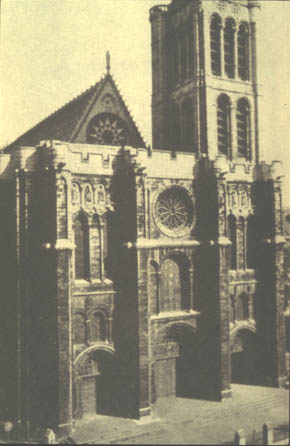
Slide 9-39: Abbey Church of St. Denis Fig. 14
Simson. The Gothic Cathedral. NY: Harper, 1956
Gothic pertains to the Goths, who had nothing to do with this kind of architecture. It was a term of derision for any "barbarian" style not Greek or Roman. It started around 1140 around Paris, followed by the Age of the Great Cathedrals, 1150-1250. By 1250 had spread over most of Europe, by 1400 an International Gothic style prevailed.
We can precisely pinpoint the origin of the Gothic style in architecture; the rebuilding of the royal Abbey Church of St.-Denis, outside Paris. The structure appears light, graceful, weightless. Ribbed groined vaulting. Much larger windows. Pointed arches. The outward pressure of the roof is contained by heavy outside buttresses between the chapels.
Janson writes, ". . . the new spirit that strikes us at St. Denis is the emphasis on strict geometric planning and the quest for luminosity. And Janson here paraphrases Abbot Sugar, who commissioned the work. "Harmony (that is the perfect relationship among parts in terms of mathematical proportions or ratios) is the source of all beauty, since it exemplifies the laws according to which divine reason has created the universe."
Chartres Cathedral of Notre Dame
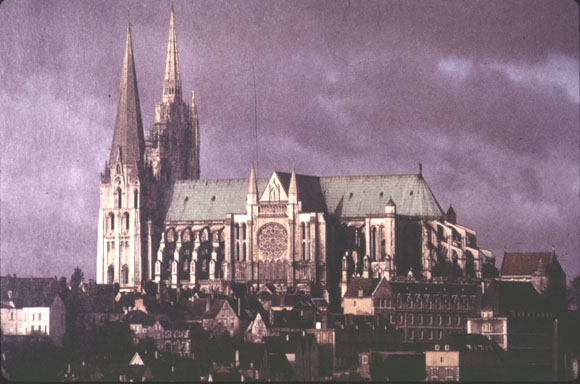
Slide 9-40: Chartres Cathedral (1145-1220)
Campbell, Joseph, with Bill Moyers. The Power of Myth. NY: Doubleday 1988.
A year after St. Denis was finished work was started on rebuilding Chartres, and it was here that the Medieval craze for numbers and geometry seemed to reach its peak. According to Cowan, "The scholars at Chartres were clearly fascinated by number and . . . geometry . . . as a key to understanding nature. Their preoccupation with numbers led to a trend of almost reducing theology to geometry."
According to Eco, "The School of Chartres remained faithful to the Platonic heritage of the Timaeus, and developed a kind of 'Timaeic' cosmology. For the School of Chartres, the work of God was order, opposite of the primeval chaos."
The Rose Window
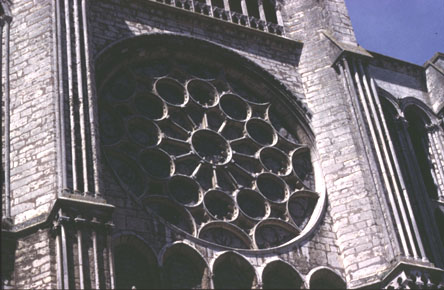
Slide 9-44: Rose Window Exterior
But the ultimate expression of the Medieval love of geometry and of the circle is the rose window, also called the Catherine window and the Wheel window. They look grand enough from outside the cathedral, but magnificent from inside, with sunlight streaming through.
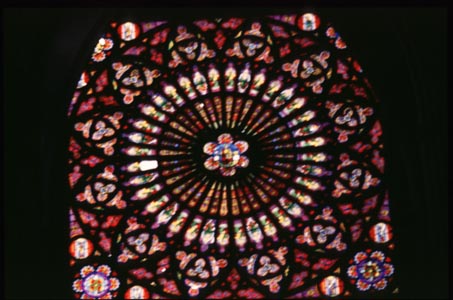
Slide 9-46: Chartres North Window, Cowan Fig. 6
According to Painton Cowan, Rose windows use geometry in three different ways; manifest, hidden, and symbolic.
Manifest:"That which makes the most immediate impact on the eye. . . the web of complexity and precision. . . each space defined by a yet smaller geometric figure - trefoil, quatrefoil, rosette, spherical triangle. . . within these can often be seen an even finer pattern woven into the glasswork . . . right down into every fibre and corner of the cosmic rose."
Hidden: "The secret geometry of the relationships and proportions of the parts."
Symbolic: "A kind of shorthand, where geometric figures represent different things."
Influence of Astrology
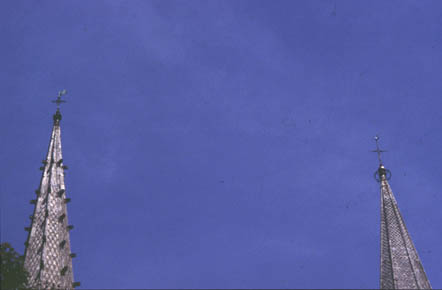
Slide 9-48: The Towers
According to Painton Cowan, the astrological number twelve is the most common number in rose windows, especially in the south transepts. At Chartres there are three large rose windows, North, South, and West, each divided into twelve segments. The influence of astrology in Chartres also shows up in the zodiac signs over doorway on the west side, in a zodiac window, and in the towers of the sun and moon, in an outdoor sundial, and an astronomical clock.
Mandorla or Vesica
Another geometric figure made from circular arcs is the vesica or mandorla, a very common geometric figure in art history. A vesica is, simply, the common area to two overlapping circles.
We'll see that the vesica has several symbolic meanings and associations;
symbolic logic almond aureole fish eye
and we'll discuss them in that order.
Venn Diagram
In symbolic logic, this figure represents the intersection of two sets, a good symbol for the intersection of Art & Geometry.
The Vesica as an Almond
The vesica is also called the mandorla because of its almond shape, a powerful symbol because a nut is the seed from which a tree grows.
The almond is often mentioned in the bible . . .
Aaron's Rod in the Old Testament was made of almond wood. In Jeremiah, ". . . behold, the rod of Aaron for the house of Levi brought forth buds, and bloomed blossoms, and yielded almonds."
In Exodus, the bowls of the menorah were to be made in the shape of almonds.
The Vesica as a Fish
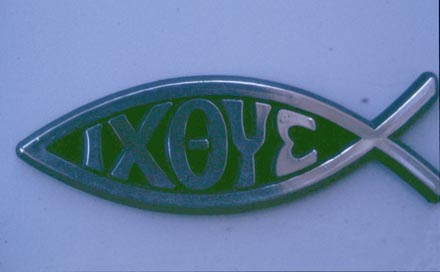
Slide 9-94: Car Medallion
Vesica pisces literally means fish bladder and if we extend the ends on one side, we get a simplified picture of a fish. The vesica is a variation of the zodiac sign for pisces, and thus has an astrological connection.
In Judaism, on the first day of Rosh Hashana Jews are encouraged to visit a body of water containing live fish and recite prayers in which we cast away our sins. "As fish depend on water so do we depend on God's providence." Also a fish's eyes never close, symbolizing God's unceasing watchfulness over us.
The fish is also a symbol for baptism. "Just as a fish cannot live without water, a Christian cannot live without the waters of baptism." A fish sometimes appears on the table in pictures of The Last Supper.
Fish in Greek is ICQUS. These letters are also the initial letters of the words, Jesus Christ God's Son Savior. This association is often given as a reason why the fish is associated with Christianity.
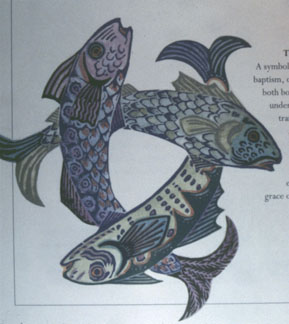
Slide 9-97: Three Fish,
Prospero. The Book of Symbols: Magic. San Francisco: Chronicle, 1944. p. 22
A figure showing Three Entwined Fish has double symbolism, both of baptism and of the Trinity.
The Vesica as Aureole
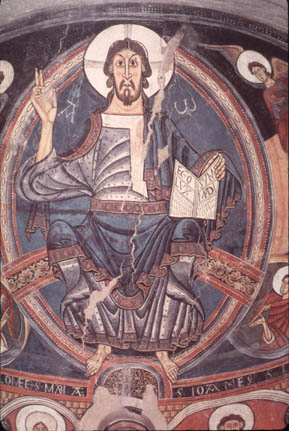
Slide 9-98: Christ Pantocrater Master of Tahull, c. 1123.
Fisher, Sally. The Square Halo. NY: Abrams, 1995. p. 91
The Middle Ages saw numerous appearances of the vesica used as an aureole, a field of radiance surrounding the entire body, a sort of body halo surrounding holy figures. This use continued into the Renaissance. It is the most common use of the vesica as an art motif. Interpreting the aureole as a Venn diagram, it could represent the uniting of God and man or the intersection of two realms, earthly and divine.
The Vesica as an Eye
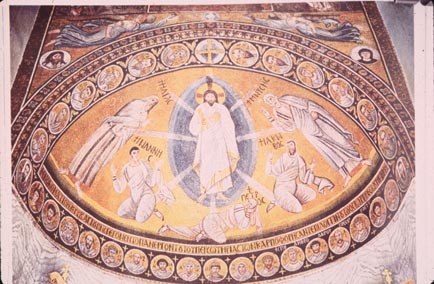
Slide 9-105: Transfiguration. Mosaic. Monastery of St. Catherine,
Mt. Sinai, Egypt. C. AD 560.
Hartt. A History of Painting, Sculpture, Architecture p 322.
As an aureole for a standing person, the vertical vesica seems a logical choice. But sometimes the vesica is horizontal. In such cases we get the impression of an eye, usually representing the omnipresent, all-seeing divinity.
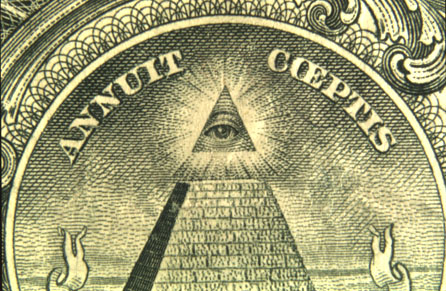
Slide 9-108: Eye on Pyramid on Dollar Bill
Joseph Campbell writes, "When you're down on the lower levels of the pyramid you will be on either one side or the other. But when you get to the top, the points all come together, and there the eye of God opens."
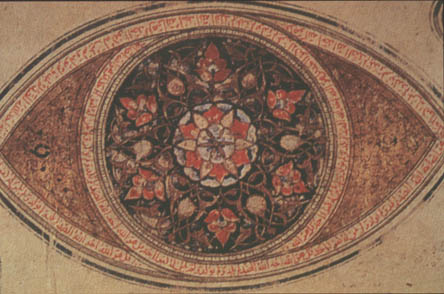
Slide 9-109: Islamic Amulet,
Prospero. The Book of Symbols: Magic. San Francisco: Chronicle, 1944. p. 13
This Islamic amulet represents the eye as a spiritual gateway leading to the soul (the circle).
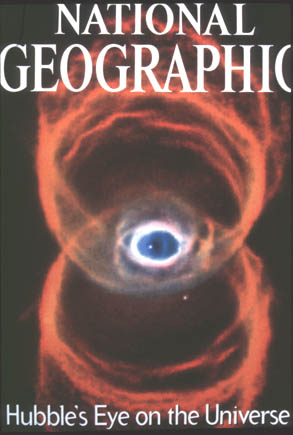
Slide 9-111: Etched Hourglass Nebula. NG Cover, April '97
National Geographic Society
In a recent National Geographic we read, "Astronomers looked 8,000 light-years into the cosmos with the Hubble Space Telescope, and it seemed that the eye of God was staring back."
Squaring the Circle
We just saw that the circle is the ultimate geometric figure, perfect, infinite, representing the divine, and we had seen that the square often represented mankind. Combining the two figures had special significance, the reconciliation of the heavenly and infinite with the earthly and man-made.
Recall from our unit on Egypt we said that the problem of squaring the circle is one of constructing, using only compass and straightedge;
(a) a square whose perimeter is exactly equal to the perimeter of a given circle, or
(b) a square whose area is exactly equal to the area of a given circle.
In that same unit we also saw that a circle whose radius is the pyramid height
1. has the same perimeter of the base of the Great Pyramid
2. and the same area as the rectangle whose width equals the pyramid's base and whose length is twice the pyramid height
Also recall the Sacred Cut construction for drawing the octagon. We said that, according to Brunés, the "sacredness" of the Sacred Cut lies in its very nearly solving the riddle of how to square the circle. The length of each arc equals the length of the diagonal of half the reference square, to within 0.6%. Thus a square of four such diagonals equals (approximately) the perimeter of a circle composed of four sacred cut arcs.
The Vesica and Squaring of the Circle
There's one more circle-squaring construction to show, that Critchlow claims was used in the layout of Hindu temples.
Draw two orthogonal vesicas. Then connect the four intersection points of the vesica to get a square. This square is approximately equal in perimeter to the original circle, a squaring that circle.
Neolithic Stone Circles
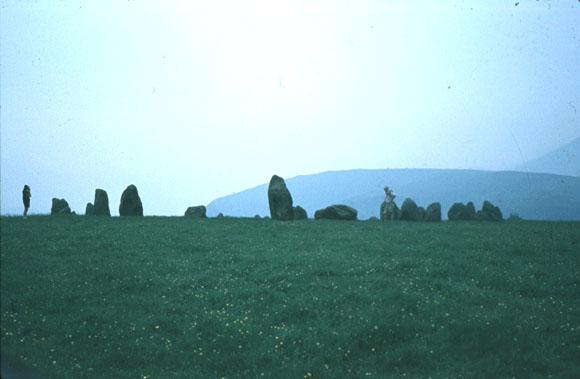
Slide 9-114: Castlerigg
We saw that Stonehenge is circular, but look at another stone "circle," Castle Rigg. The most striking thing about this ring is that it is flattened. In fact, many of the rings in Britain are flattened.
Why Flattened? Why go to the trouble of producing a flattened circle
when a circular shape is so much easier to produce? Recall that the
diameter of a circle will fit around the perimeter of the circle three
times, plus a bit more, actually p times,
where 
 3.1416. . . , an irrational number.
3.1416. . . , an irrational number.
The speculation about why a stone circle was flattened was to make its perimeter an integral multiple of the radius drawn to their circular part of its perimeter.
Why? According to Critchlow, "The constructions . . . were typical of those which numerically rationalize the perimeter of the primary circle. This balance between 'irrational' geometry and rational numbering is a fundamental reconciliation lying at the roots of sacred geometry. . . "The squaring of the circle is a . . . symbol [of] . . . the establishing of Heaven on Earth . . .."
It was an attempt to rationalize the irrational.
The Molten Sea
Another example of a circle with a perimeter that is an integral multiple of the diameter is found in the bible. I KINGS, Chapter 7 reads like an installment of This Old House, where Solomon is building a house and fetched Hiram, who was "filled with wisdom and understanding, and cunning. . . ", sort of a biblical Norm Abrams. Hiram, among other things, "made a molten sea, ten cubits from one brim to the other: it was round all about . . . and a line of thirty cubits did compass it round about."
I suspect that those dimensions approximate. If they are accurate, then the outline must have been flattened, like some neolithic stone circles.
Mandala
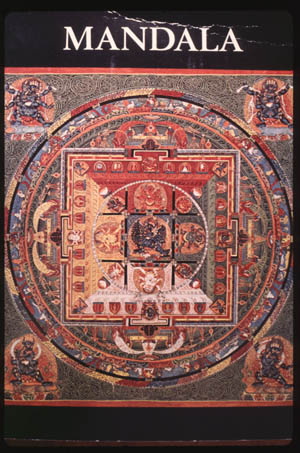
Slide 9-112: Tibetan Mandala of Yamaktaka, from Arguelles cover
The most beautiful examples of squaring the circle can be seen in the Indian or Tibetan mandala. In Sanskrit, Mandala literally means circle and center or Holy Circle, and is essentially a vehicle for concentrating the mind.
Note that a Mandala often contains a square as well as a circle, and even if the square does not "square" the circle the symbolism is still there.
Carl Jung says that the circle symbolizes the processes of nature or of the cosmos as a whole; the square refers to the universe as conceived and projected by man.
Summary
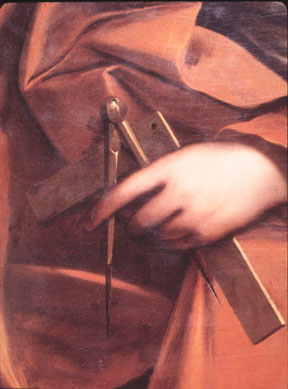
Slide 9-124: Compass and Square Dust jacket detail
Kemp, Martin, The Science of Art. New Haven: Yale U. Press, 1990.
We've seen several recurring themes in this unit, and in preceding ones. They are:
- Reconciliation of Opposites
- Transcending duality.
- Finding a Middle Ground Between Extremes
- Mediating Between the Earthly and Divine
Specific symbols that we've seen relating to these themes are:
| Vesica | Shows the duality of two circles, and also common ground. |
| Golden ratio | Represents the golden mean between two extremes. |
| Pyramids | Square the circle and reconcile triangle and square. |
| Vitruvian Man | Man inside a square and also a circle. |
| Flattened circle | An attempt to rationalize the irrational. |
| Mandala | Squares the circle. |
| Star of David | One triangle pointing to heaven intertwined with another pointing to earth. |
| Sri Yantra | Some triangles point upwards to the heavenly, others downward to the earthly. |
| Chrismon | A cross within a circle, uniting earthly and divine. |
| Compass & Square | Represents the squaring of the circle by means of the instruments used. |
| Orthogonal vesicas | Square the circle |
| Yin-Yang Symbol | Intertwined dark and light figures, reconciled by outer ring. |
| Rainbow | Connects heaven and earth |
All of these can be seen as a geometric symbols of mankind's attempt to get in good with the cosmic forces that control our lives, and that's what religion tries to do.
Reading
Cowan, pp. 80-125
Lawlor pp. 31-35
Jung, Man and His Symbols, pp. 240-249.
Janson. The Chapter on Gothic Art
Eco
Arguelles
